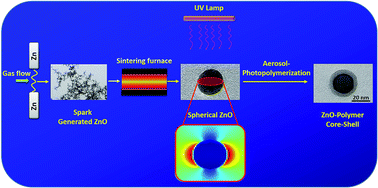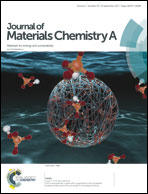Surface-initiated polymerization on unmodified inorganic semiconductor nanoparticles via surfactant-free aerosol-based synthesis toward core–shell nanohybrids with a tunable shell thickness†
Abstract
The work presented here describes a facile approach toward the in situ coating of various inorganic semiconductor nanoparticles (ISNs) including ZnO, TiO2, and Fe3O4 with a hydrophobic polymer shell by a surfactant-free aerosol-based synthesis method. In this regard, fresh spherical ZnO nanoparticles were initially generated by spark discharge followed by a sintering process in the gas phase. Then, the resulting ZnO nanoparticles exhibit excellent performance in photocatalytic surface-initiated polymerization of the butyl acrylate monomer in the continuous aerosol-photopolymerization, within the average aerosol residence time of 35 s in the photoreactor. This method is based on heterogeneous condensation of monomer vapor around the surface of gas-borne ISNs, which is then polymerized “in flight” under UV light irradiation. In this one-pot synthesis, ISNs not only act as inorganic cores, but also at the same time are able to release charge carriers (electron–hole pairs) upon photoexcitation which drive the free radical polymerization near their surface. Therefore, no added initiator is required. To further investigate the basis and the mechanism of our experimental results, the optical properties of ZnO nanoparticles during the UV irradiation in the gas phase process were simulated by a three-dimensional finite difference time-domain (FDTD) method. Moreover, the coating efficiency was evaluated by aerosol photoemission (APE) and the results demonstrate that monomer and polymer coating efficiencies are 99% and 80%, respectively. Then, to verify the generality of this method toward coating, different kinds of ISNs, such as rod-like ZnO, TiO2 P25, and magnetic Fe3O4 nanoparticles, were used as inorganic cores and photoinitiators. More importantly, with proper control of the experimental conditions, the polymer shell thickness can be easily tuned at the nanoscale. Finally, the successful change in the surface hydrophobicity of ISNs after the encapsulation with the polymer shell was confirmed by their preference for an organic solvent. Compared with conventional wet methods, the presented aerosol-photopolymerization process is fast, avoids the need for surfactants, co-initiators and surface modification of ISNs before the polymerization and produces core–shell nanostructures continuously.



 Please wait while we load your content...
Please wait while we load your content...